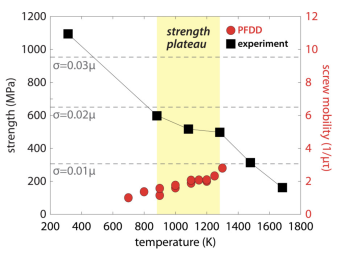New paper: Understanding the mechanism behind athermal strength in MoNbTi
March 01, 2024
Using a three-dimensional phase field dislocation dynamics approach combined with Langevin dynamics, we simulate the glide mechanisms of screw and edge dislocations at elevated temperature and low stress levels in the refractory multi-principal element alloy MoNbTi with a body-centered cubic, random solid solution structure. For 600−1200 K, edge-dislocation glide is smooth, temperature sensitive, and faster than screw dislocation glide. Screw dislocations exhibit three distinct glide mechanisms over the same temperature range. Ultimately, the formation of nonplanar kink pairs that ensues above 900 K reduces screw mobility with respect to temperature and leads to athermal mobility from 1100 to 1200 K.


